After haunting the morning sky through August and during the early part of September, Comet C/2023 P1 Nishimura has moved up into the evening sky.
Comet-watchers and stargazers around the world have been heading out after sunset to look for Comet Nishimura low in the west as twilight deepens.
Discover our pick of the greatest comets of recent times and find out what comets and asteroids are in the sky tonight
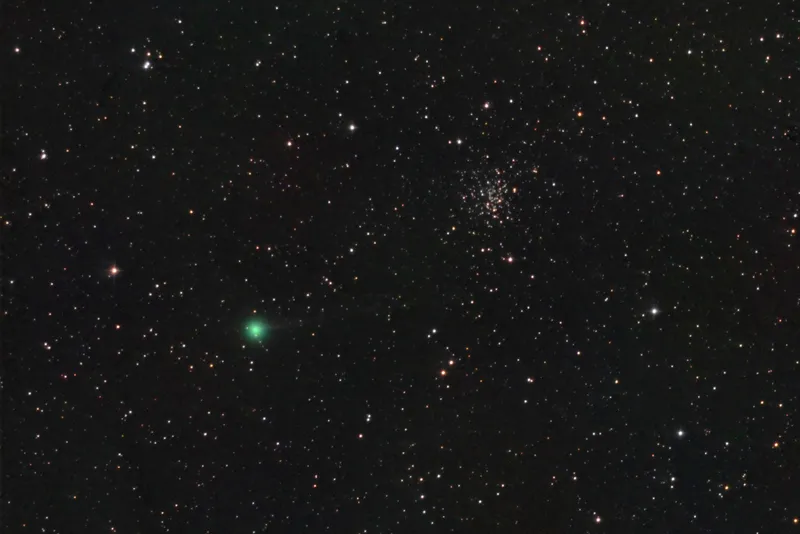
Comet P1 Nishimura's discovery
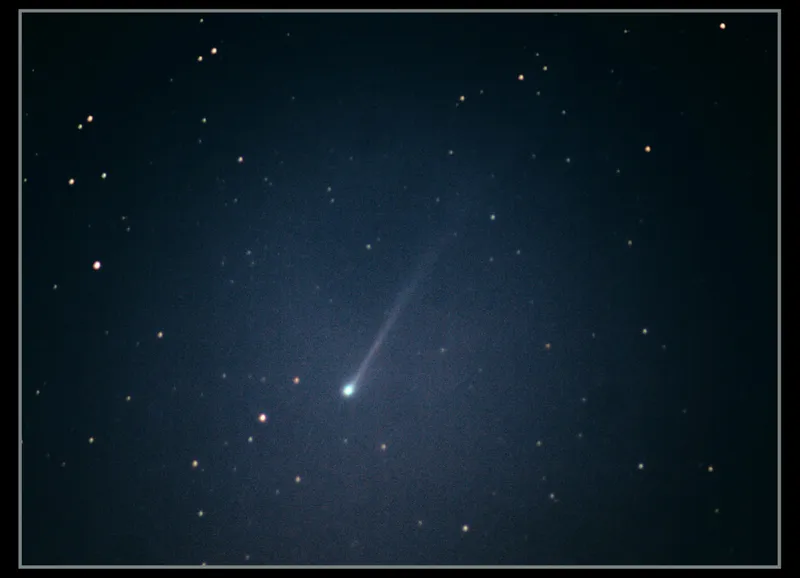
C/2023 P1 (Nishimura) is a long period comet that was discovered by Hideo Nishimura on 12 August 2023.
He was using a 200mm f/3 telephoto lens mounted on a Canon EOS 6D DSLR camera.
Calculations have since shown that Comet Nishimura has an orbital period of around 437 years.
The comet was in Gemini and shining at around 10th magnitude when it was discovered.
But it has been brightening steadily and is now in Leo.
I’ve taken photos of it over the past few mornings, from the 800 year old ruins of Kendal Castle in Cumbria, UK.
My images taken using a DSLR camera, tracking the sky on a motorised mount, show it has grown a short but very pretty forked tail.
This tail would definitely look more impressive against a darker sky.

What Comet Nishimura is doing now
By the time P1 Nishimura departed the morning sky it was shining at third magnitude and sporting a tail that was at least 10° long.
It looked looked lovely in long exposure photos even though it wasn’t visible to the naked eye.
This degree of activity suggested to some that the comet would be a good binocular object – and might even become visible to the naked eye - after moving up into the evening sky.
The most optimistic wondered if the comet would grow an even longer, even brighter tail, making it easier to see.
However, the majority of seasoned comet observers warned that Comet P1 Nishimura would be so low in the sky, and the sky would be so bright, that it would be very challenging to see.
This appears to be how things have played out.

While very experienced comet observers and imagers have managed to spot P1 shining in the evening sky, it has not been easy to find.
It has definitely not been obvious to non-astronomers.
As predicted at the very beginning, the comet has brightened to second magnitude.
But as impressive as that would make it high in a dark sky that’s nowhere near bright enough for it to shine clearly through the evening twilight.
Even the best comet imagers have only managed to record it as a fuzzy gold-hued star with a hint of a fan-shaped tail behind it, almost overwhelmed by the twilight.
Comet P1 Nishimura is still going to be visible in the evening sky for a short time yet, but it seems safe to assume that its best days are behind it.
Unless something spectacular happens and it suddenly develops a long, bright tail that overcomes the brightness of the sky, P1 is now going to slowly fade from view.
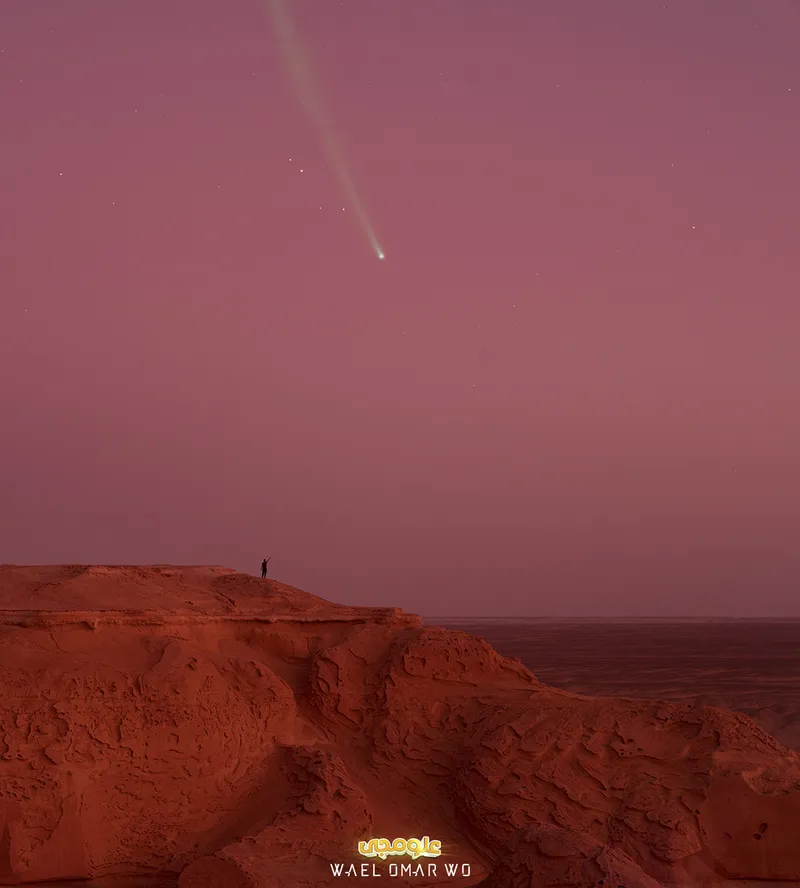
No doubt astrophotographers will continue to hunt for it.
Visual observers will continue to seek out low, flat western horizons and sweep the sky above them with their binoculars, hoping for one more glimpse of it, but essentially the show is over.
As is always the way now, unfortunately, there was a lot of media hype about this comet.
The usual suspects shouted out how it would “light up the sky!” and “blaze bright green in the sky!”
But that was never going to happen.
In the end Comet P1 Nishimura did exactly what experts predicted it would do. It didn’t under-perform, it didn’t disappoint.
It shone nicely in the morning sky for a few weeks and then faded from view after moving up into the evening sky.
So if you didn’t see it don’t feel too bad. P1 was never – despite what some suggested – going to be another Hale-Bopp or NEOWISE.
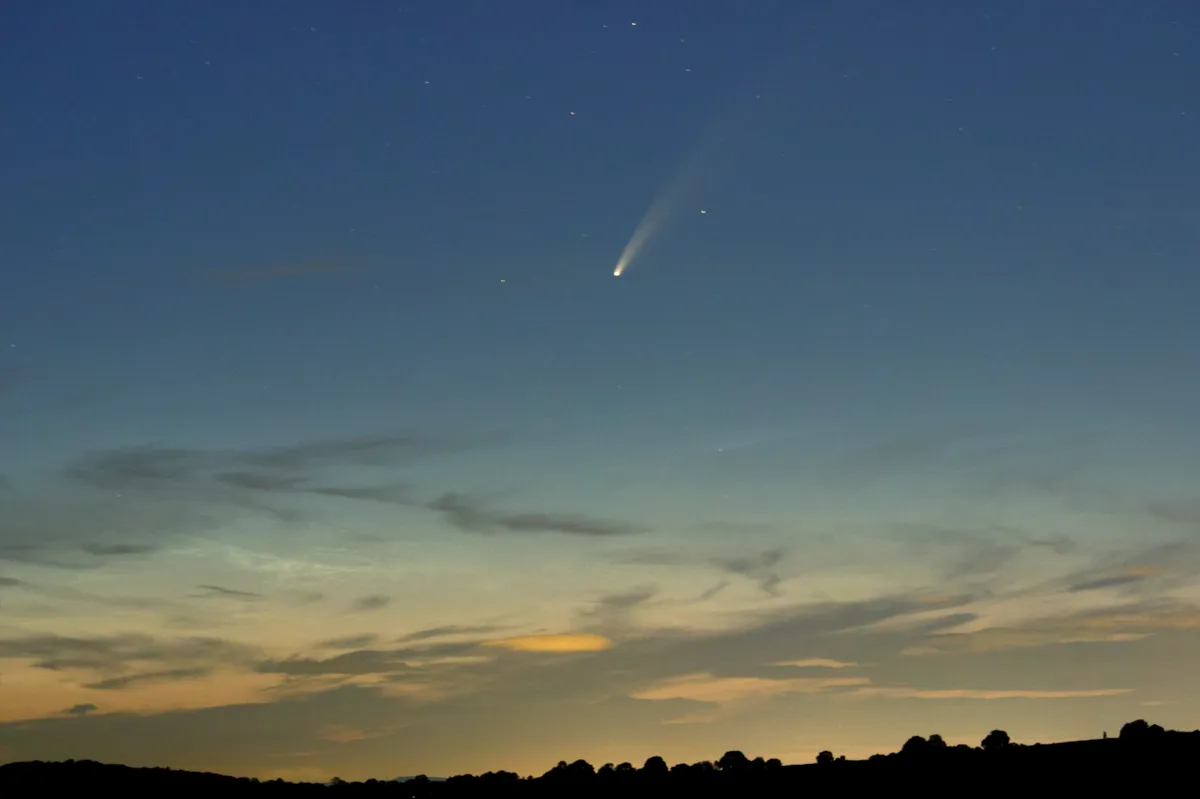
It was a nice sight in binoculars and small telescopes, and a truly beautiful photographic object, but nothing more.
There will be other comets in our sky in the months and years ahead, and most will be nowhere near as bright as P1, that’s just the way things are.
But there will be brighter ones too, perhaps much brighter ones, and even as you read this there’s a comet far, far out in space that is destined to be as bright or even brighter than Hale-Bopp or NEOWISE.
We just haven’t found it yet.
So, farewell P1 and thank you. We’ll see you again in less than 500 years!

Comet Nishimura - the story so far
How we reported on Comet Nishimura over the past few weeks...
Have you seen Comet P1 Nishimura yet? Comet C/2023 P1 has been putting on quite a show in the morning sky for experienced comet observers.
Comet Nishimura, or C/2023 P1 (Nishimura) to use its official designation, is currently visible in the morning sky in the constellation Leo.
So what can we expect from Comet Nishimura over the coming week? And will it reach naked-eye brightness?
For the past couple of weeks amateur astronomers have been getting up before sunrise to try and catch a glimpse of a comet that was discovered on 11 August 2023.
Comet C/2023 P1 Nishimura was in the constellation Gemini when it was discovered, and as it moved from Gemini and into Cancer it began to brighten to the point where it was easily visible in small telescopes and on long exposure photos too.
By the time P1 had moved into Leo it had brightened even more, and there were even a few reports of it being visible to the naked eye.
Long exposure photos showed intricate detail and structure in its long narrow tail too.
The comet brightened considerably - some observers' reports described it as being magnitude 5 - and its tail has grown much longer and more complicated too.
Long exposure images of P1 have shown a narrow blue-grey tail stretching out behind its bright green head to a length of ten degrees, with many whirls and swirls and streamers of material embedded within it.
It's been visible through a telescope or a good pair of binoculars and is really shining in the many images that have been circulating online over the past weeks.
As the comet moves through the Sickle of Leo in the sky before dawn, observers in many countries have been enjoying looking at it through binoculars and telescopes
Reports of Comet P1 Nishimura being visible to the naked eye have also been increasing.
All of which is leading to cautious optimism among many comet observers that when P1 moves up into the evening sky it might well be an attractive sight in binoculars, and possibly visible in with the naked eye too.

What is Comet Nishimura doing now?
Comet Nishimura is now sporting a tail that is ten degrees long, possibly longer.
And if the latest estimates of it being as bright as third magnitude are correct it would be a lovely sight if it was well away from the Sun, high in a dark sky, easily visible to the naked eye.
Unfortunately it is almost the exact opposite: it's getting closer and closer to the Sun, and so deep in the morning marmalade twilight that it is extremely hard to see.
Most observers have given up even trying.
And as they catch up on much-needed sleep, comet-chasers are now waiting to see what it will do after it swings up into the evening sky, reappearing low in the north-west after sunset.
The first evening observations and images should come in soon, and those who are following the comet and its development are eager to see what will look like.
Will Comet Nishimura get really bright?
Remember how, just over two years ago, we were all gazing up wistfully at beautiful Comet NEOWISE shining in the summer sky?
With its long tail it was a lovely sight as it drifted beneath the Big Dipper, and was clearly visible to the naked eye.
Frustratingly, there have been no obvious naked eye comets since then - so many have been hoping that Comet Nishimura could be the one.
However, it's important to not get carried away here, as many in the popular media are doing.
The comet will not "blaze in the sky", "light up the heavens" or put on "a dazzling display for skywatchers".
It is not going to be another Hale-Bopp.
The best we can hope for is that after rounding the Sun and drifting up into the evening sky, P1 will be bright enough to see with the naked eye as an elongated smudge low in the west, as twilight deepens.
Perhaps with a short, vapour-trail like tail that catches the eye.
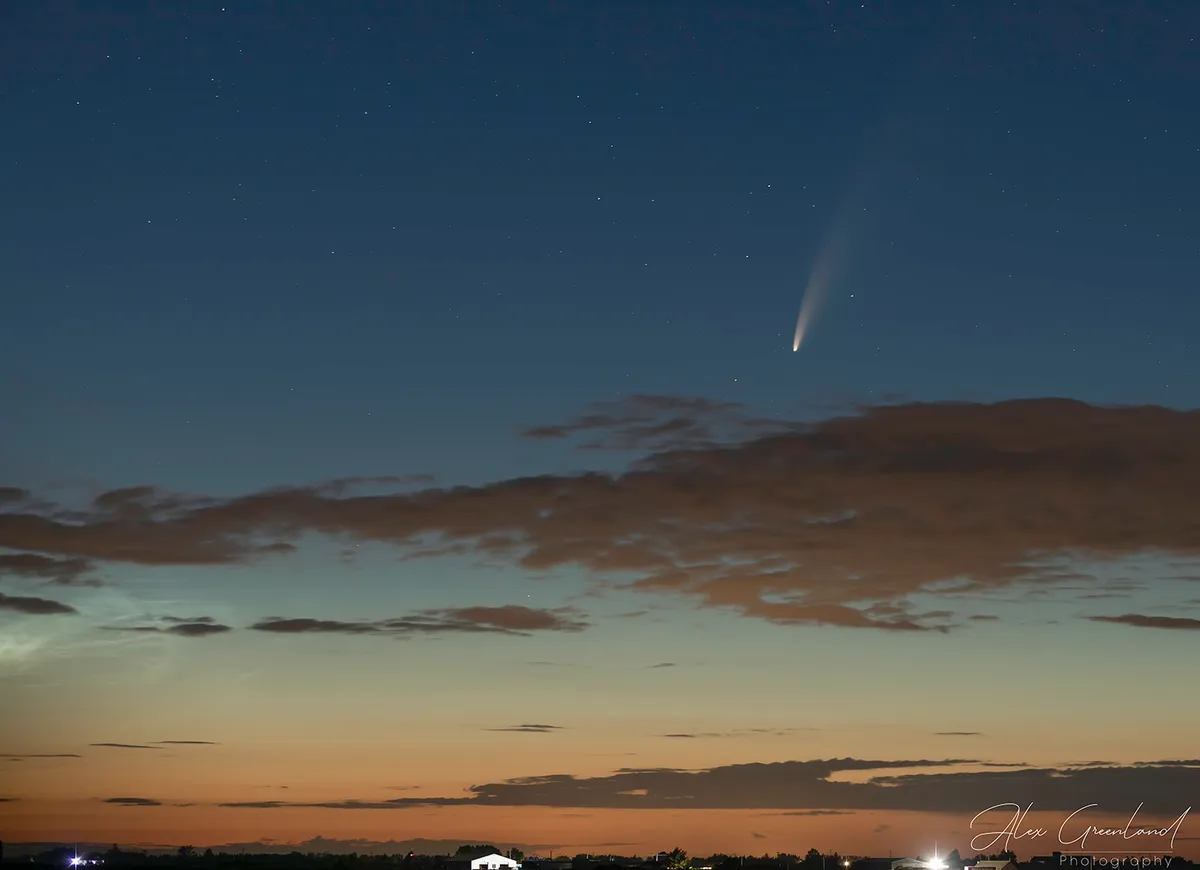
Will Comet Nishimura be visible to the naked eye?
Comet Nishimura, if it follows predictions, might become visible to the naked eye after the weekend of 9/10 September when it moves into the evening sky.
But it's very possible that the comet will be not be easily visible to the naked eye.
It may be overwhelmed by the brightness of the evening sky and its own low altitude.
This would make it visible only in binoculars or telescopes to skywatchers who know what they're looking for.
We'll just have to wait and see.
It’s important to bear in mind that when it comes to comets 'visible to the naked eye' does not mean 'will be a stunning sight to the naked eye”'
It just means that it might reach a magnitude high enough to be seen without help from binoculars or a telescope.
Comet Nishimura could possibly get bright enough to be seen only as a smudge in the sky, or possibly something a lot better.
There’s always a chance the comet will 'do an ISON' and break apart as it rounds the Sun, but it’s showing no signs of doing that so far.
So comet observers are cautiously optimistic that more than just a cloud of debris will sweep up into the evening sky.

What can we expect from the comet?
Comet P1 Nishimura will reach its closest point to Earth on 12 September 2023 and its closest point to the Sun on 17 September 2023.
At this point it will have moved up into the evening sky. And what might we see then?
If you remember, Comet NEOWISE was a lovely sight because it was high in a dark sky.
Comet P1 will not be. It will remain firmly embedded in the evening twilight, always low in the sky, until it fades away.
Calculations suggest that it might reach a maximum magnitude of 2.
Which of course would make it obvious in a darker sky.
But low in the twilight it will appear fainter than that, perhaps merely a smudgy star in binoculars.
However, if the tail continues to grow it might make the comet more obvious.
And it may yet surprise us with an impressive tail, pointing up from the horizon, beneath the curved handle of the Big Dipper and Arcturus.
The bottom line is we just don’t know what’s going to happen.
There are three possibilities, really.
Firstly, the comet will be so faint that it will be totally overwhelmed by the post-sunset glow.
We won’t be able to see it, even in binoculars never mind with the naked eye.
You might remember that soon after it was discovered the comet was predicted to reach a peak magnitude of 2, which sounds bright
And like Polaris and the stars of the Big Dipper, which are also second magnitude, it would be clearly visible to the naked eye at that magnitude if it was high in a dark sky.
But not only will P1 be very low in the sky, just above the horizon, it will be battling against the bright twilight, and it will be a fuzzy, extended object too, not a single starlike point.
So, as you can see the odds are against it, and us. But…

There’s also a chance that the comet will get brighter than second magnitude, and if it does that will make it easier to see, especially with binoculars.
If the long tail it has been developing over the past week or so continues to grow that will also improve our chances of seeing it, as that tail might reach beyond the 'dome' of the sunset twilight and catch the eye, but we can’t count on that..
What about the best-case scenario? What might happen if we all close our eyes really tight and cross our fingers and toes and everything else?
IF the comet gets brighter than second magnitude, and IF its tail continues to grow in length, and IF it has a sudden burst of dust production and blossoms a bright dust tail, it MIGHT be visible to the naked eye later this week.
But even if all those things happen it will still be low in the sky and fighting the twilight; there’s no escaping those challenges.
So, all we can do now is wait and see what happens over the rest of this coming week.
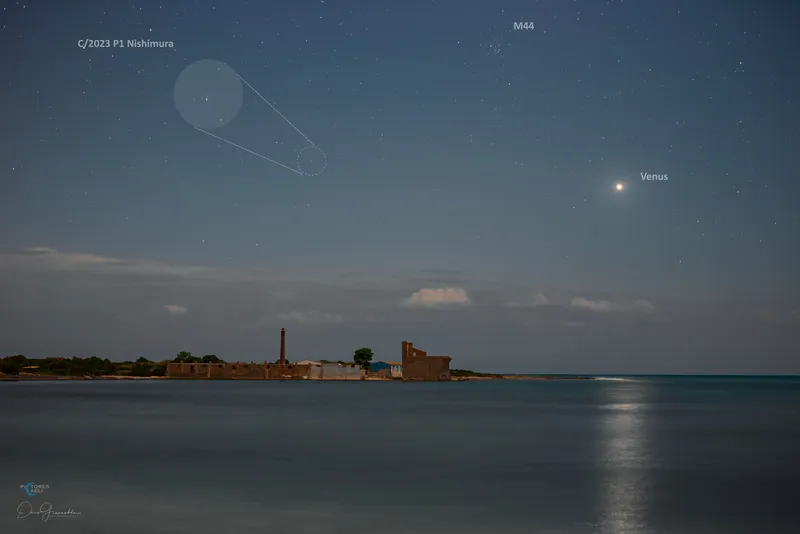
How to see Comet Nishimura
Over the past few weeks the advice for those wanting to see Comet Nishimura has been to get up early, around 4am, and looki for a smudge to the left of brilliant Venus.
The best thing to do now, however will be to head out if your sky is clear, look to the north-west and see what’s there, sweeping the sky above the horizon if you don’t see anything with your naked eye.
If you have a camera that can take time exposures you should try photographing the sky in that direction too, as your camera might well pick up the comet even if your eye can’t.
The images of P1 being posted online now are stunningly beautiful, showing what looks like a huge comet with a dramatic tail of blue and silver trailing away behind it like some medieval banner.
But it's important to remember they have been taken by very experienced and skilled astrophotographers using very expensive and sophisticated equipment.
The comet on those lovely images is not what you will see with your own eyes, or even through binoculars or a telescope.
If you just see a smudge in the morning sky you'll have done well!
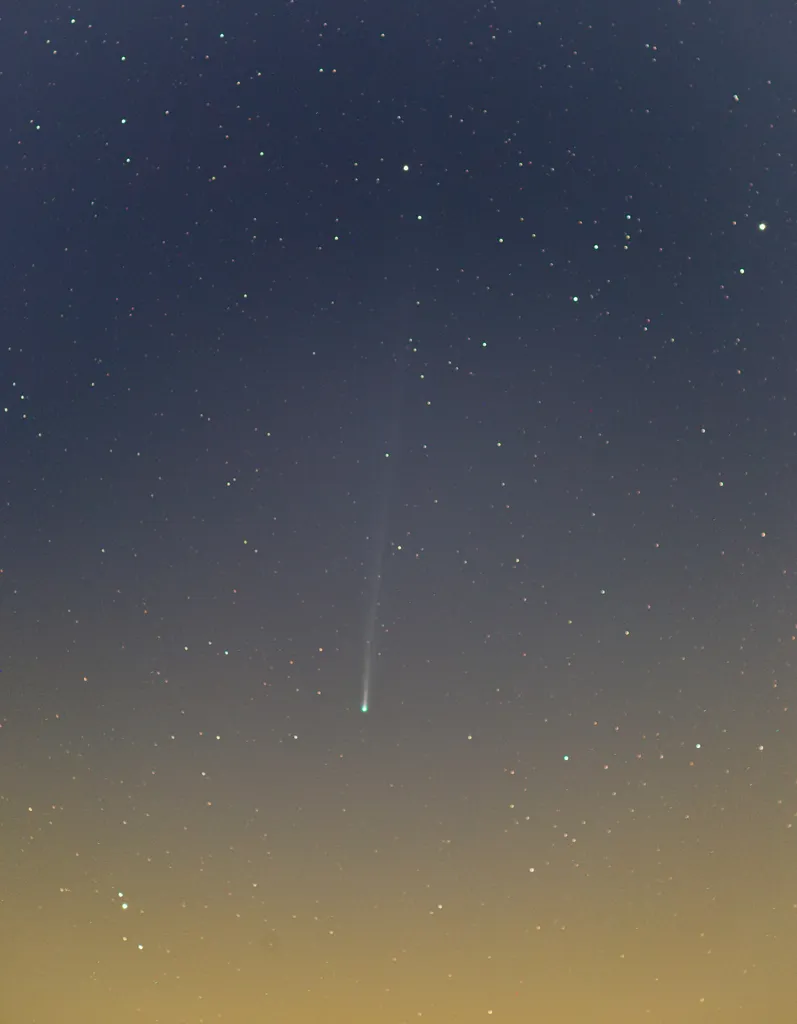
If you don't manage to see Comet Nishimura, don't feel too bad.
This was always going to be a very challenging comet to spot, due to its low brightness and close proximity to the Sun.
There will be other comets in the future which will be brighter and better placed.
And P1 itself will be back again in less than 500 years…!
Have you observed or photographed Comet P1 Nishimura? Let us know by emailing contactus@skyatnightmagazine.com
